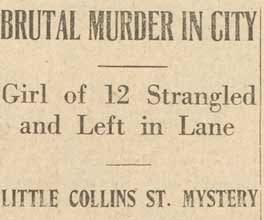The Gun Alley Murder
On 31 December 1921, the body of 12-year-old Alma Tirtschke was found in a laneway. Alma had been raped, strangled and left naked behind a popular wine saloon. The murder became known as the ‘Gun Alley Murder', and was front-page news for months.
Theories about the killer began to circulate. There was a strong rumour that a Chinese man had been arrested, but this was unfounded. The German community was also targeted. Eventually, the owner of the wine saloon, Colin Ross, was arrested and tried for Alma's rape and murder.
The police based its prosecution on the presence of golden hairs on two blankets in Ross's saloon. The hairs were examined by a government scientist, and found to match a sample cut from Alma's hair at the autopsy. However, the blankets weren't taken from the saloon for weeks after the event, and once they had been seized, they weren't kept in a secure location, but thrown on a desk.
A modern court would require much stricter handling of evidence – and much stronger evidence to convict – but in 1922 this was enough to see Ross tried for the crime.
The trial was a public one, given the amount and type of press coverage it received. Newspapers had published photographs of Ross, which wouldn't be allowed today as it could influence a witness's true recollection of events. The judge asked the jury to keep an open mind, but as a report in a popular newspaper of the time stated:
Ross had been tried by public opinion before the jury went into the box. Mr. Maxwell (barrister appearing for Ross) had significantly said: 'It is not the evidence here I fear, it is the preconceived opinion'... the extraordinary publicity given to the charges made it impossible for any average collection of men to clear their mind of convictions on one side or the other.
– Midnight Sun, 31 December 1922
Morgan, K 2005, Gun alley: murder, lies and failure of justice, Simon and Schuster, Pymble, N.S.W.
Today, if a juror believes media coverage of a crime has biased their opinion of a suspect, they can be excused from jury duty.
The prosecution's case was strengthened by the testimonies of two witnesses who claimed that Ross had confessed the crime to them. One, however, was a convicted criminal who was in gaol with Ross; the other was a former female employee of the saloon who reportedly held a grudge against him.
Both witnesses may have been motivated by the £1000 reward for information, which they later received, or influenced by media coverage. Nevertheless, although Ross denounced their stories in court, he was found guilty and sentenced to death by hanging.
In 1998, the hairs on Ross's blankets were re-examined using modern technology, and it was found that they were not from Alma's scalp. On 27 May 2008, in a landmark decision, the Victorian State Government announced a posthumous pardon for Colin Ross – nearly 90 years after his execution.
</p></div></div>











